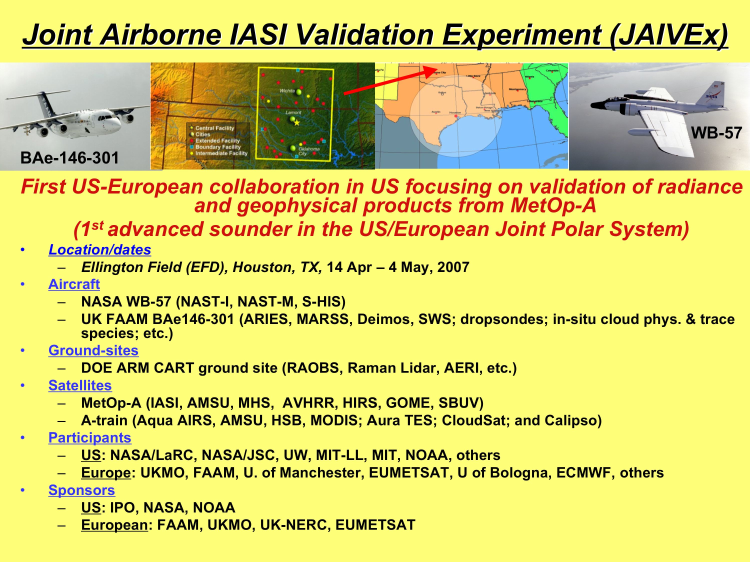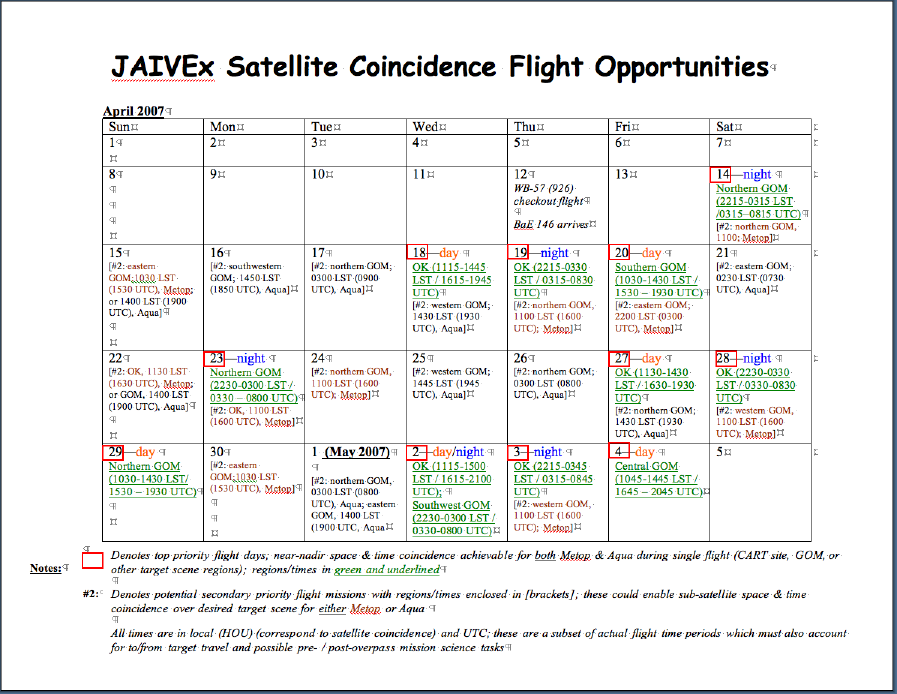Overview
The Joint Airborne IASI Validation Experiment is an international cal/val campaign in support of the NPOESS and MetOp series of operational satellites. Although all measurements on the MetOp-A and A-train satellites are of interest, the focus of JAIVEx is on the validation of radiance observations and meteorological products from the Infrared Atmospheric Sounding Interferometer, IASI. IASI, on MetOp-A launched 19 October, 2006, is the first of the advanced ultra-spectral resolution temperature, humidity, and trace gas sounding instruments to be flown on the Joint Polar System (JPS) of NPOESS and MetOp operational satellites for the purpose of improved weather, climate, and air quality observation and forecasting. IASI measures radiation emission from the surface and atmosphere in the 645 – 2760 cm-1 (i.e., 3.6-15.5 μm) spectral band with high spectral resolution (i.e., 8461 spectral channels with a spacing of 0.25 cm-1). As MetOp-A orbits overhead, IASI scans the Earth between ± 49° providing a swath of data across the Earth of 2132 km. The scan swaths are made with a frequency to provide contiguous coverage across the Earth’s surface as the satellite orbits overhead. Seven consecutive orbits, each with a 101 minute period, provides total Earth coverage every twelve hours. The aircraft being employed are the NASA WB-57 and the FAAM BAe 146.The aircraft base location, dates of the experiment, satellite, airborne, and surface resources being used for JAIVEx, as well as the participants and sponsors, are summarized below.
Flight Missions: The surface targets of the cal/val flight missions will be the DoE Atmospheric Radiation Measurement (ARM) facility in north central Oklahoma and the Gulf of Mexico. The ARM facility is well instrumented with in-situ and ground based remote sensors, as desired for meteorological product validation, while the Gulf of Mexico provides a relatively uniform surface background, as desired for spectral radiance measurement validation. One important goal of the JAIVEx is to intercompare MetOp-A operational measurement capability with that provided by the A-train of advanced NASA research satellites. Although the orbits of the MetOp and the A-Train are about four hours apart (MetOp-A being in a 09:30 descending orbit and the A-train being in a 13:30 ascending orbit), the aircraft missions will generally be of six hours duration to permit underflights of both the MetOp and the A-train satellites. The aircraft sensors can be used as a relative calibration transfer reference for each of the satellite systems (e.g., the difference between MetOp and aircraft measurements can be compared to the difference between A-train and aircraft measurements) in order to account for space and time difference between the measurements from the two satellite systems. This capability is expected to be particularly useful for characterizing the differences between the spectral radiance measurements and derived products from the Aqua AIRS and the MetOp IASI advanced sounding instruments. The figure below shows the days during JAIVEx where cross comparisons between the A-train and the MetOp are possible over the Oklahoma ARM site and the Gulf of Mexico.
For a more complete description of the experiment and a description of the facilities involved, the reader is referred to the JAIVEx Operations Manual.

 Joint
Airborne IASI Validation Experiment (JAIVEx) at UW-Madison SSEC/CIMSS
Joint
Airborne IASI Validation Experiment (JAIVEx) at UW-Madison SSEC/CIMSS Flight Opportunities Calendar
Flight Opportunities Calendar
